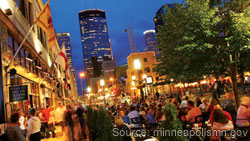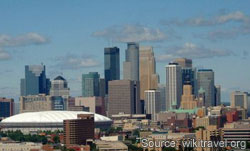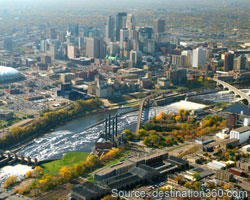Situated by the Mississippi River, this city is known as the cultural headquarters of Minnesota. Vibrant yet conservative in its outlook, the city is the best place to experience a fusion of cultures. From being a flour milling capital to one of the most sought after cities in the Midwest, Minneapolis has come a long way.
 Owing to the presence of wetlands and numerous lakes, the city is known by the nickname "City of Lakes". Parks developed around these lakes offer plenty of opportunities for outdoor activities like fishing, ice skating, boating, and picnics.
Owing to the presence of wetlands and numerous lakes, the city is known by the nickname "City of Lakes". Parks developed around these lakes offer plenty of opportunities for outdoor activities like fishing, ice skating, boating, and picnics.
The city is abundant in malls and theme parks - the Nickelodeon Universe is the largest indoor family theme park. It also features America's largest underwater aquarium, which offers some of the best shark encounters you'll see in an aquarium.
Here is a guide that will help you relocate smoothly to Minneapolis.
Minneapolis Climate
The city's climate is classified as a humid continental climate. Extremes of weather from hot and humid summers to subzero temperatures in the winter can be experienced in the city.
Due to the location of the city in the center of continental America and a lack of natural barriers, the range of temperature is widest from 7o F to 83o F. The city is susceptible to Arctic air masses that result in freezing temperatures and strong winds. Rain, snow, sleet, and freezing rain are some of the types of precipitation the city experiences.
Tall buildings obstruct wind and help to trap heat near the surface resulting in a phenomenon called urban heat island effect, where the temperature in the city is higher than the immediate surrounding areas. The city is also susceptible to tornadoes and experiences an average of one annually, resulting in millions of dollars in damages. Derechos are weaker than tornadoes but wind and hail cause damage over large areas. Significant flooding has been observed in the Mississippi River over the last few years.
Minneapolis Neighborhoods
The city of Minneapolis is comprised of 11 communities which are divided into 81 neighborhoods. Camden is mostly a residential community with two industrial areas. Everything from parks and museums, to historic sites and skyscrapers can be found in the downtown neighborhood of Central.
 Named after the writer Henry Wadsworth Longfellow, the Longfellow community features a mostly middle- and working-class community. This community houses the Mississippi River Gorge regional park which is a protected area. Although Philips is one of the diverse communities where you can find people from different nationalities, it also ranks high in crime rate.
Named after the writer Henry Wadsworth Longfellow, the Longfellow community features a mostly middle- and working-class community. This community houses the Mississippi River Gorge regional park which is a protected area. Although Philips is one of the diverse communities where you can find people from different nationalities, it also ranks high in crime rate.
The Powderhorn neighborhood reflects a friendly vibe with parks, lakes, and attractions like Eat Street and the Minneapolis Institute of Arts. The Southwest community is a mostly residential neighborhood where you will find houses built before World War II. Due to its location to the Downtown area, the University community has been gentrified significantly. It is now mostly occupied by students and there are plenty of cheap restaurants and coffee shops.
Living Costs in the City
Higher healthcare and insurance costs are balanced by cheaper housing, which is almost 30 percent cheaper than any area in the Midwest. Due to a shorter growing season, fresh fruits and vegetables are costly as they are mostly shipped from outside, although there are a great variety of farmers markets that sell their produce at acceptable prices.
The sales tax in Minneapolis is 7.75 percent. Apparel and shoes are cheaper in the city as the state of Minnesota doesn't apply any sales tax. When compared to the national average, wages in the city are higher and the unemployment rate is lower. Vehicle maintenance costs are higher due to cold climates and due to the prevention of accidents on icy roads.
Registering Your Car
Upon your arrival in Minnesota after moving to the state permanently, you have a total of 60 days to update your registration and have your vehicle registered in the state before you may be required to pay a penalty.
A Minnesota Driver's License can be obtained at any Minnesota DMV location. The state requires new Minnesota residents to update their license from their previous state to a Minnesota driver's license by completing a written test and a vision test. If your existing out-of-state license has been expired for longer than a year, you will also be required to take a road test as well.
Minneapolis Moving Resources
 There are hundreds of reputable and reliable moving companies in the city of Minneapolis to help you with your move and get you unloaded and unpacked in your new home. Whether you're moving from within the state of Minnesota, or whether you're moving from the East or even the West coast, you'll find moving companies that can help you get settled in Minneapolis. Here are just a few of places where you can find movers to handle your relocation to Minneapolis:
There are hundreds of reputable and reliable moving companies in the city of Minneapolis to help you with your move and get you unloaded and unpacked in your new home. Whether you're moving from within the state of Minnesota, or whether you're moving from the East or even the West coast, you'll find moving companies that can help you get settled in Minneapolis. Here are just a few of places where you can find movers to handle your relocation to Minneapolis:
In addition, there are also many storage companies located within the city in case you need a place to store some of your belongings, whether it's for a short amount of time until you get settled in your new home, or for more long-term storage. You can find yourself a Minneapolis storage company to help fulfill your storage needs right here.
Public Transportation
Metro transit manages public transportation in the city, and provides a network of buses, rail, and commuter trains for residents of the city. To relieve the common fears among commuters about being stranded during late hours, metro transit as part of the Guaranteed Ride Home program has been distributing free travel vouchers. Since 2006, the city has operated a night owl service - a 24-hour service and high-frequency network created for certain routes. With the help of low-floor design and hydraulic lifts, all of the city's buses can be easily accessed by handicapped patrons. Under the metro mobility paratransit system, a door-to-door transportation service is also available.
Culture and Contemporary Life
Dubbed by its residents as the Mini Apple - a smaller version of the Big Apple - the city exhibits a rare combination of liberal politics and conservative family values. Minneapolis stands at third place in the U.S. behind New York City and Chicago in the theater market. Some of the city's most famous theaters include the Minnesota Dance Theatre, the Puppet and Mask Theatre, the Lundstrum Center for the Performing Arts, and Theater Latte Da.
 One of the state's largest festivals, the Minnesota Fringe Festival, takes place in the city. The Guthrie Theater is Minneapolis' answer to Broadway, designed by Jean Nouvel, a French architect. The credit for designing some of the finest parks in the country goes to Horace Cleveland. The chain of lakes and other geographical features are well preserved in his landscape architecture. The Minneapolis Institute of Arts houses sculptures, paintings, drawings, photography that reflects 4,000 years of world history.
One of the state's largest festivals, the Minnesota Fringe Festival, takes place in the city. The Guthrie Theater is Minneapolis' answer to Broadway, designed by Jean Nouvel, a French architect. The credit for designing some of the finest parks in the country goes to Horace Cleveland. The chain of lakes and other geographical features are well preserved in his landscape architecture. The Minneapolis Institute of Arts houses sculptures, paintings, drawings, photography that reflects 4,000 years of world history.
The ruins of Washburn Mill have been converted into the Mill City Museum that showcases the flour milling industry through various exhibits and games. The Museum of Russian Art is the only museum in all of North America where Russian art and artifacts are presented. From decadent dairy to fine dining to local restaurants offering their version of charcuterie, Minneapolis cuisine is rich and varied. Various rural food festivals like Brahm's pie day, Barnesville potato days, and Montgomery kolache days are also organized.
Moving to Minneapolis
Vibrant and sophisticated, the city has people from neighboring states gravitate to its rich variety and resources that it has to offer especially in education, entertainment, and employment. Based on affordable housing, high quality of life, and access to entertainment, Forbes in 2007 named the city "the most affordable place to live well".
Weather plays a major role while moving to Minneapolis. Extremes of weather can make it difficult for the movers to move your belongings. Sometimes the weather can take a turn for the worst in a matter of seconds and bring down a blizzard. You should take into account this uncertainty factor while planning for your move. Check for moving company credentials like license and insurance before hiring one. Inquire with your moving company about any parking permits and elevator bookings - whether they will take care of it for you or whether you'll be required to handle it.
Minneapolis Relocation Tips
- Weather is highly unpredictable in the city with sudden changes in a matter of seconds. Listen to the weather report and plan accordingly for your move.
- The local newspaper Star Tribune and Minnesota public radio are two sources to find out about what is happening locally.
- Fragile items like crystal and china should be packed well with extra padding. The boxes containing these items should be labeled FRAGILE and necessary precautions should be taken while loading and unloading.
- Celebrate your new life in the city with tiny ceremonies like a walk around the lake, or buying that perfect cup of coffee at a café.
For the first few months after relocation, there will be lots of gaps in your calendar. Try to fill those gaps with meaningful activities like completing a painting, joining a health club or learning a new form of dance.